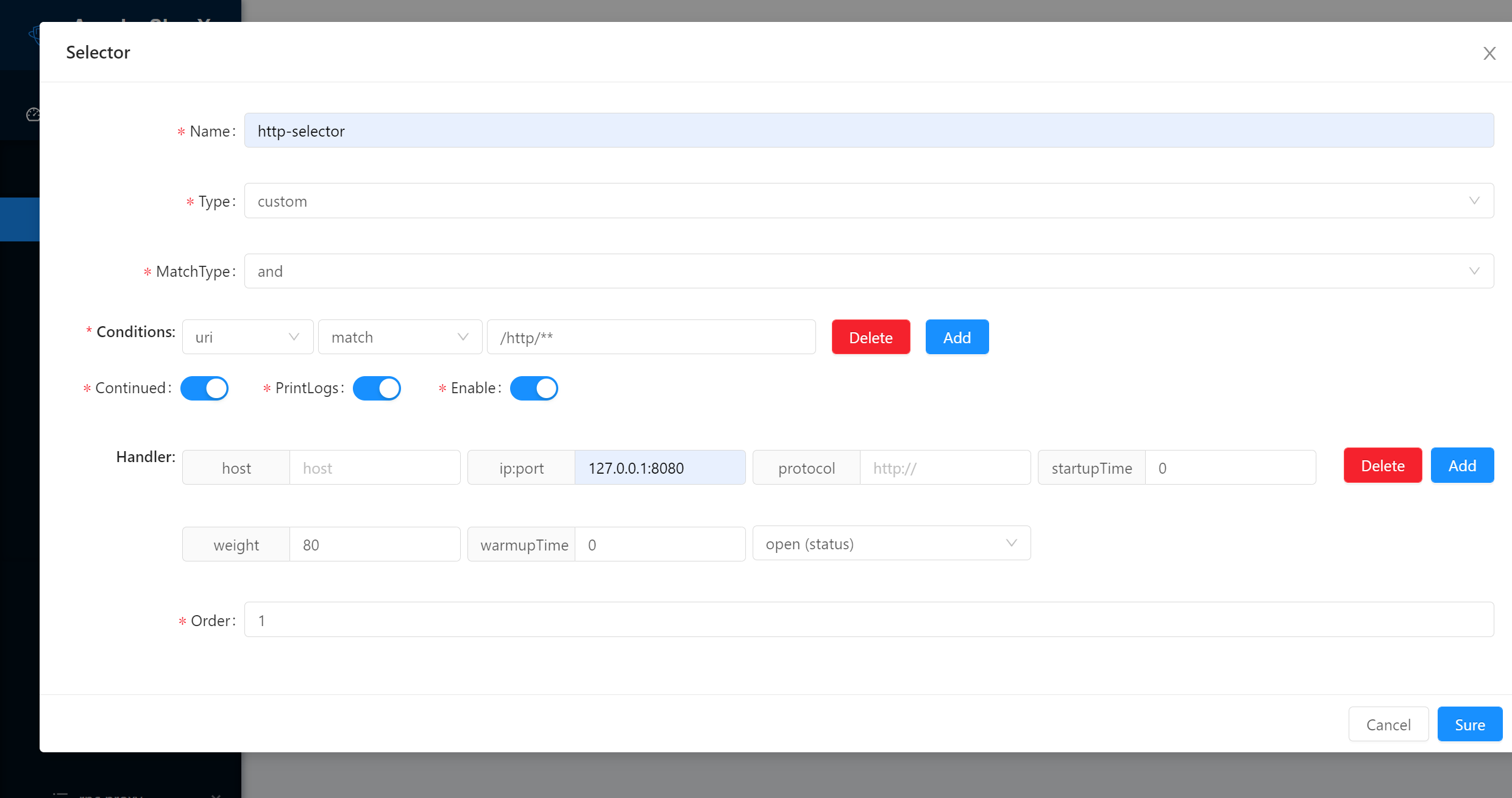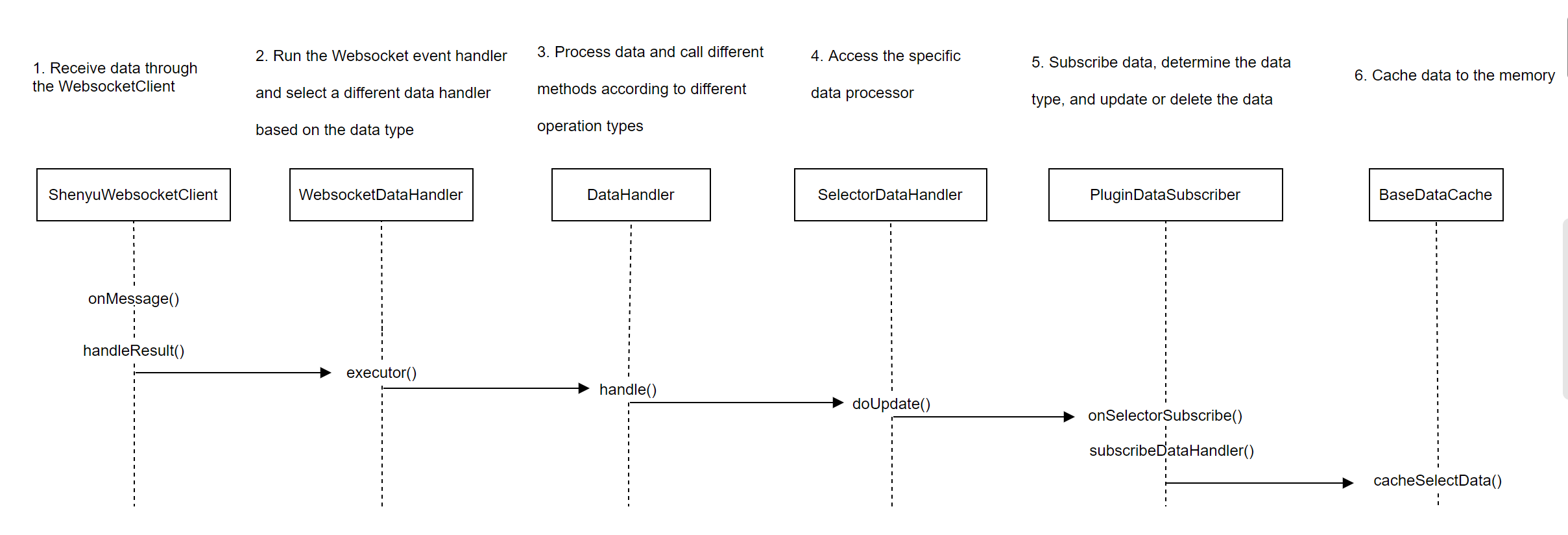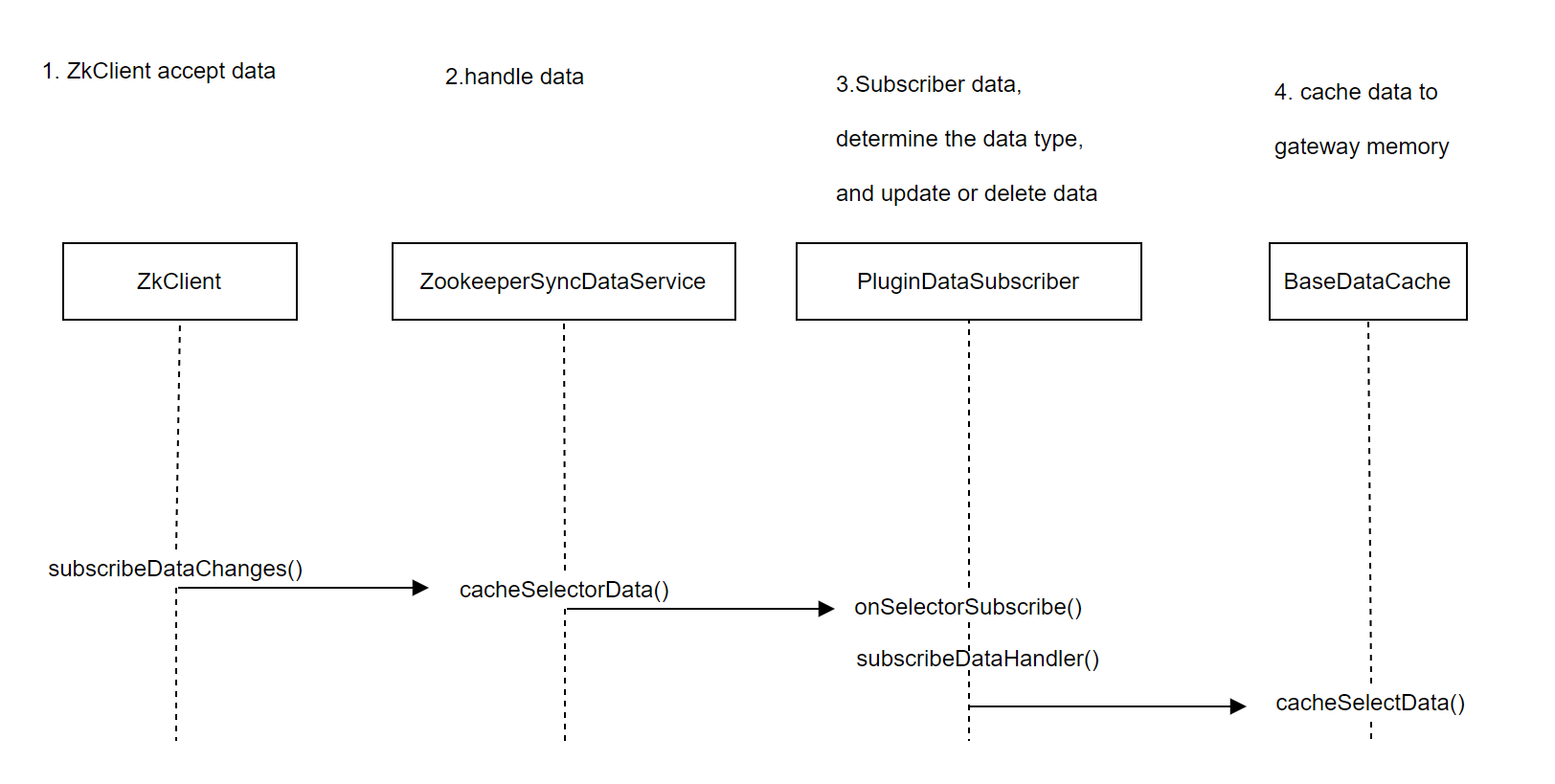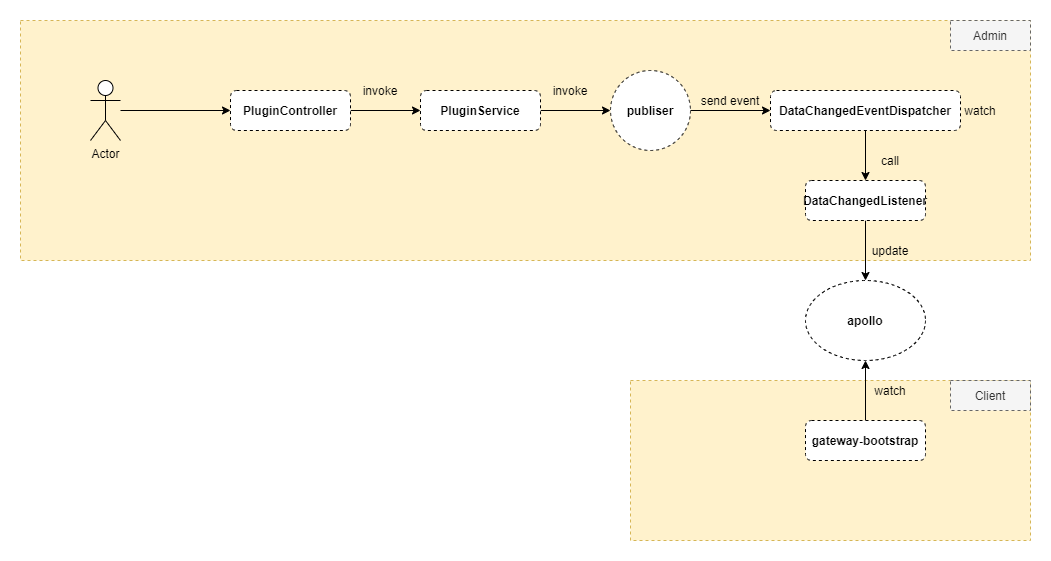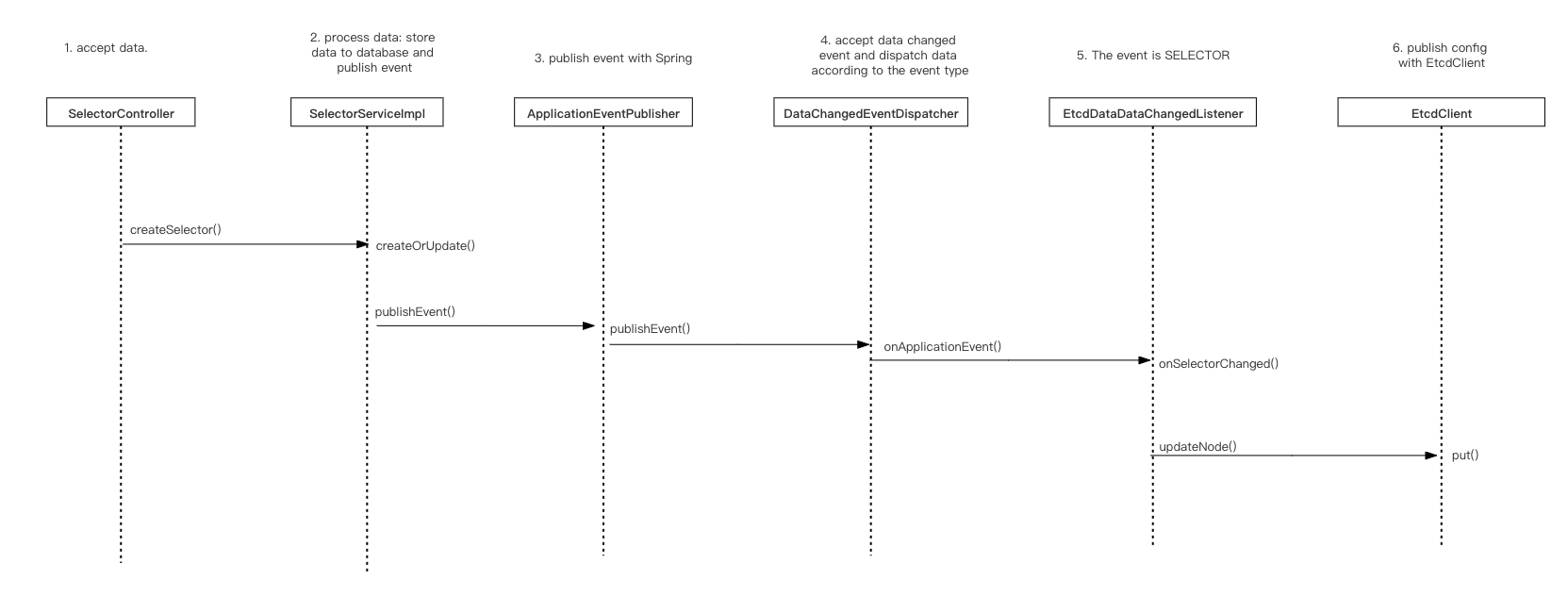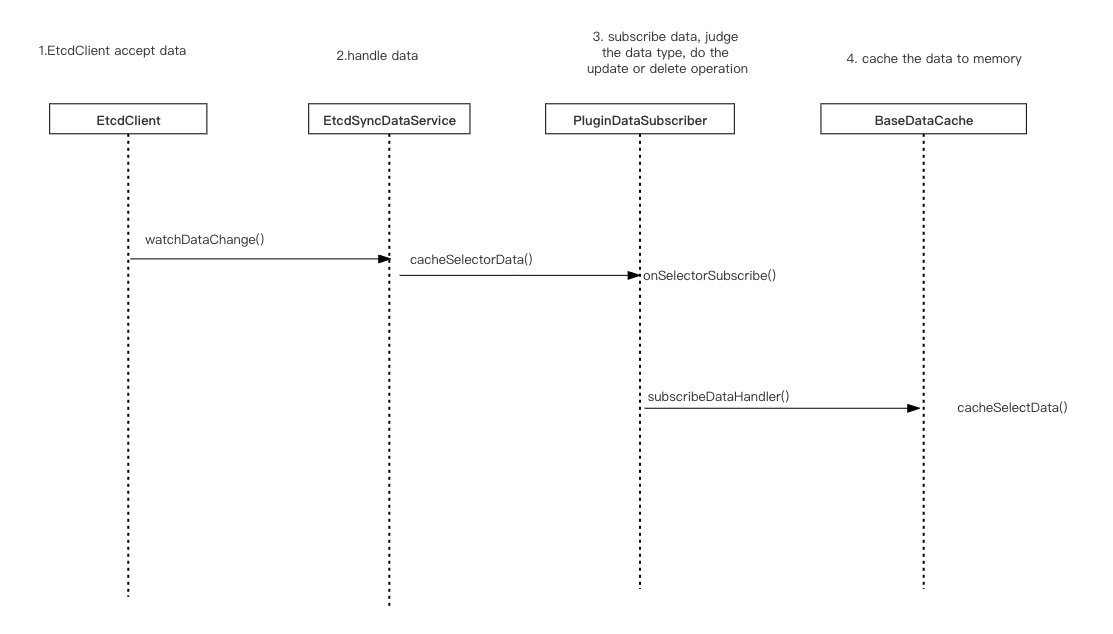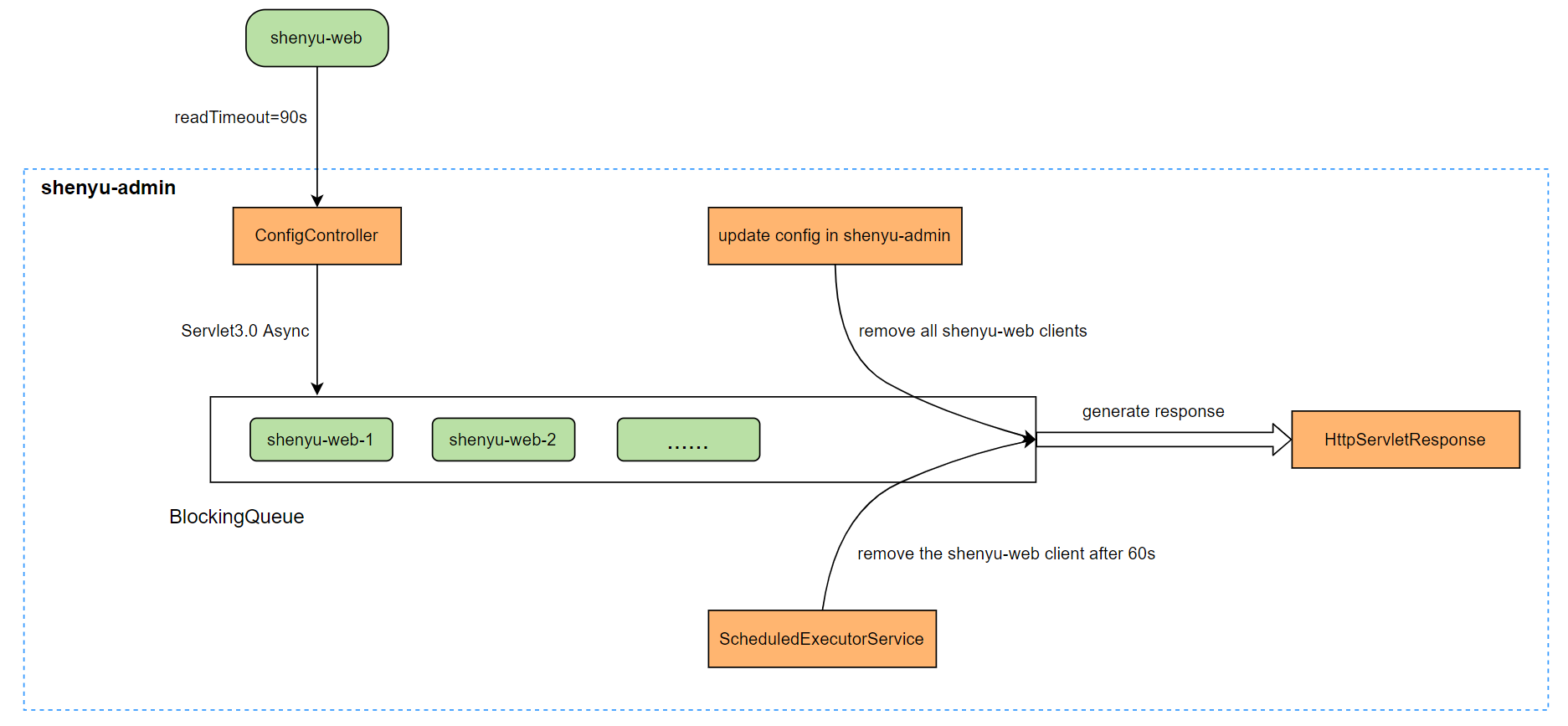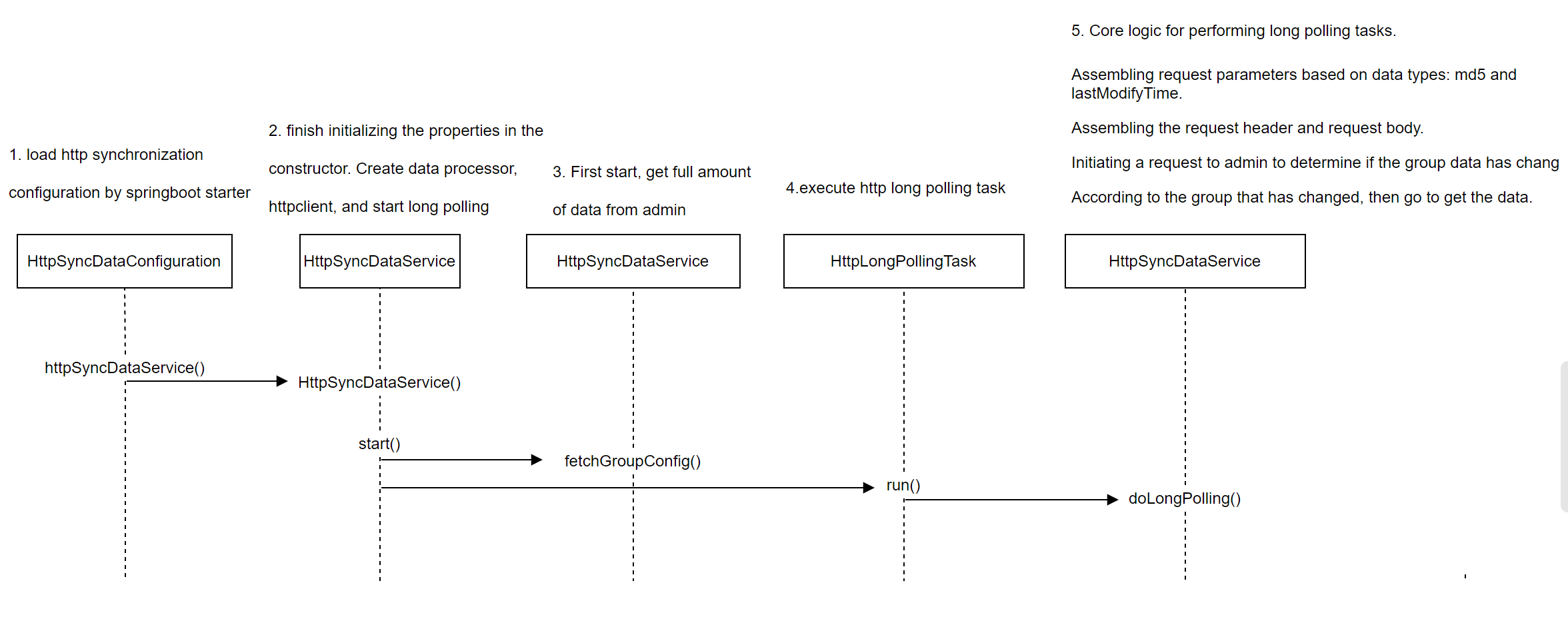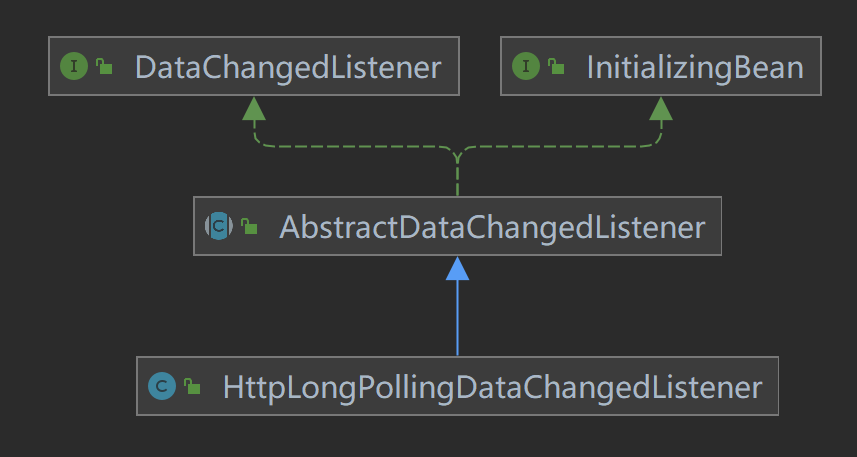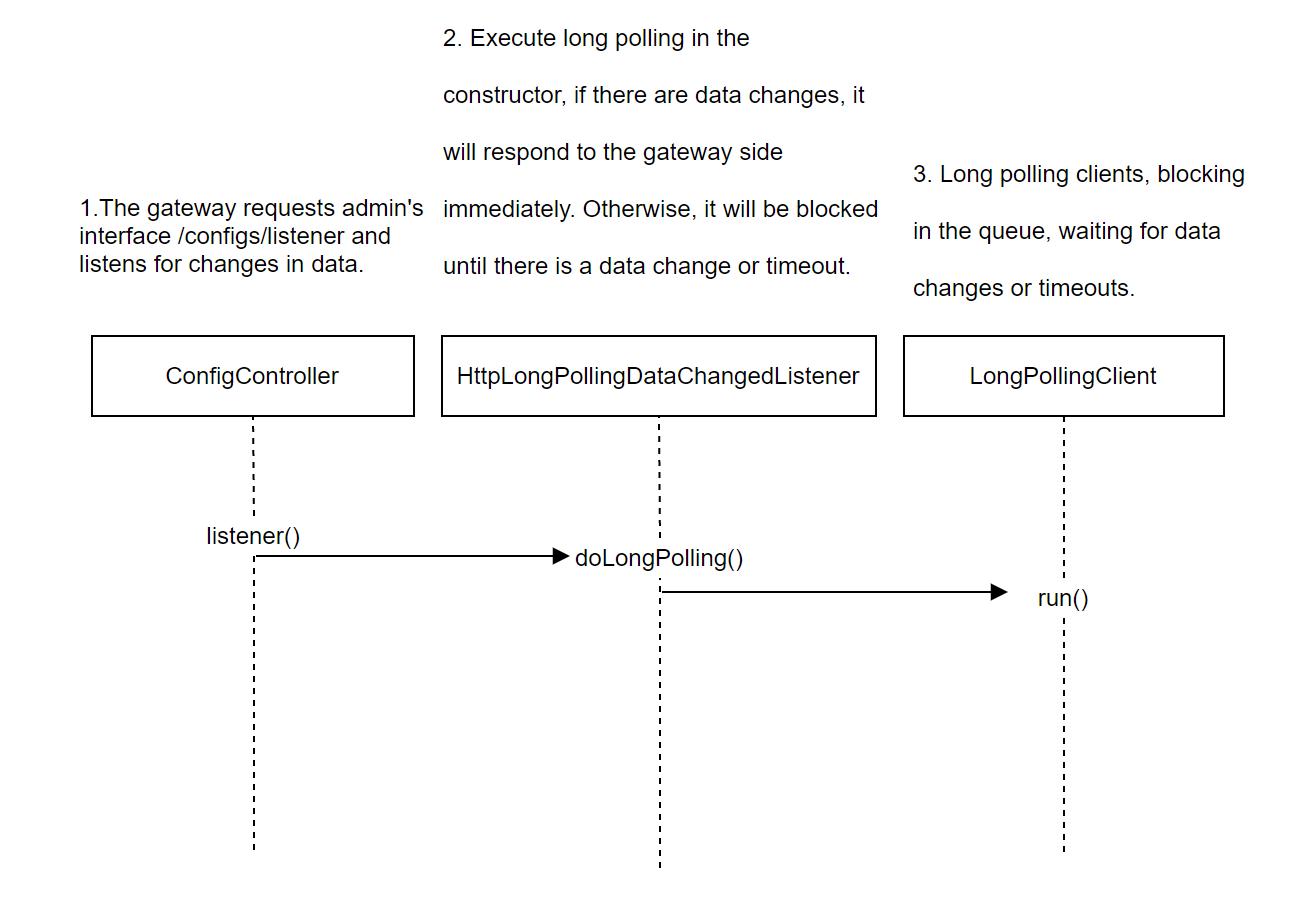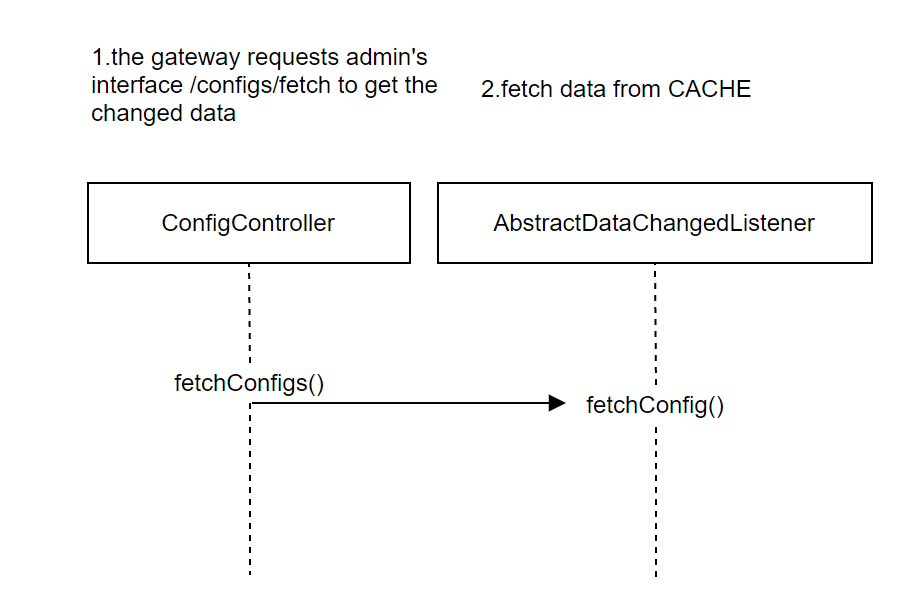Nacos Data Synchronization Source Code Analysis
Apache ShenYu is an asynchronous, high-performance, cross-language, responsive API gateway.
In ShenYu gateway, data synchronization refers to how to synchronize the updated data to the gateway after the data is sent in the background management system. The Apache ShenYu gateway currently supports data synchronization for ZooKeeper, WebSocket, http long poll, Nacos, etcd and Consul. The main content of this article is based on Nacos data synchronization source code analysis.
This paper based on
shenyu-2.4.0version of the source code analysis, the official website of the introduction of please refer to the Data Synchronization Design .
1. About Nacos#
Nacos can be used for dynamic service discovery and configuration and service management. Shenyu use Nacos as an option to sync data.
2. Admin Data Sync#
We traced the source code from a real case, such as updating a selector data in the Divide plugin to a weight of 90 in a background administration system:
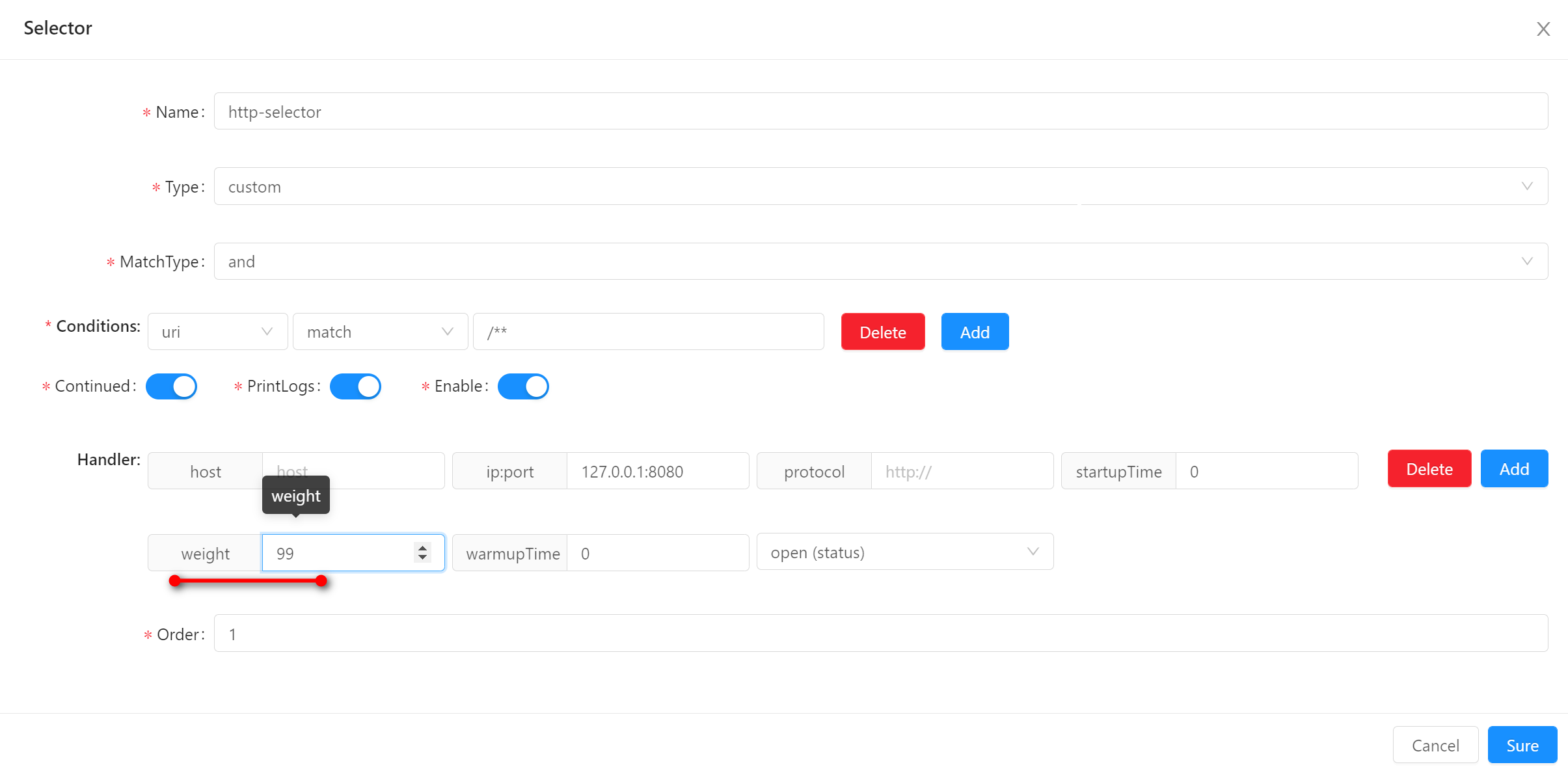
2.1 Accept Data#
- SelectorController.createSelector()
Enter the createSelector() method of the SelectorController class, which validates data, adds or updates data, and returns results.
@Validated@RequiredArgsConstructor@RestController@RequestMapping("/selector")public class SelectorController { @PutMapping("/{id}") public ShenyuAdminResult updateSelector(@PathVariable("id") final String id, @Valid @RequestBody final SelectorDTO selectorDTO) { // set the current selector data ID selectorDTO.setId(id); // create or update operation Integer updateCount = selectorService.createOrUpdate(selectorDTO); // return result return ShenyuAdminResult.success(ShenyuResultMessage.UPDATE_SUCCESS, updateCount); } // ......}2.2 Handle Data#
- SelectorServiceImpl.createOrUpdate()
Convert data in the SelectorServiceImpl class using the createOrUpdate() method, save it to the database, publish the event, update upstream.
@RequiredArgsConstructor@Servicepublic class SelectorServiceImpl implements SelectorService { // eventPublisher private final ApplicationEventPublisher eventPublisher; @Override @Transactional(rollbackFor = Exception.class) public int createOrUpdate(final SelectorDTO selectorDTO) { int selectorCount; // build data DTO --> DO SelectorDO selectorDO = SelectorDO.buildSelectorDO(selectorDTO); List<SelectorConditionDTO> selectorConditionDTOs = selectorDTO.getSelectorConditions(); // insert or update ? if (StringUtils.isEmpty(selectorDTO.getId())) { // insert into data selectorCount = selectorMapper.insertSelective(selectorDO); // insert into condition data selectorConditionDTOs.forEach(selectorConditionDTO -> { selectorConditionDTO.setSelectorId(selectorDO.getId()); selectorConditionMapper.insertSelective(SelectorConditionDO.buildSelectorConditionDO(selectorConditionDTO)); }); // check selector add if (dataPermissionMapper.listByUserId(JwtUtils.getUserInfo().getUserId()).size() > 0) { DataPermissionDTO dataPermissionDTO = new DataPermissionDTO(); dataPermissionDTO.setUserId(JwtUtils.getUserInfo().getUserId()); dataPermissionDTO.setDataId(selectorDO.getId()); dataPermissionDTO.setDataType(AdminConstants.SELECTOR_DATA_TYPE); dataPermissionMapper.insertSelective(DataPermissionDO.buildPermissionDO(dataPermissionDTO)); }
} else { // update data, delete and then insert selectorCount = selectorMapper.updateSelective(selectorDO); //delete rule condition then add selectorConditionMapper.deleteByQuery(new SelectorConditionQuery(selectorDO.getId())); selectorConditionDTOs.forEach(selectorConditionDTO -> { selectorConditionDTO.setSelectorId(selectorDO.getId()); SelectorConditionDO selectorConditionDO = SelectorConditionDO.buildSelectorConditionDO(selectorConditionDTO); selectorConditionMapper.insertSelective(selectorConditionDO); }); } // publish event publishEvent(selectorDO, selectorConditionDTOs);
// update upstream updateDivideUpstream(selectorDO); return selectorCount; } // ...... }In the Service class to persist data, i.e. to the database, this should be familiar, not expand. The update upstream operation is analyzed in the corresponding section below, focusing on the publish event operation, which performs data synchronization.
The logic of the publishEvent() method is to find the plugin corresponding to the selector, build the conditional data, and publish the change data.
private void publishEvent(final SelectorDO selectorDO, final List<SelectorConditionDTO> selectorConditionDTOs) { // find plugin of selector PluginDO pluginDO = pluginMapper.selectById(selectorDO.getPluginId()); // build condition data List<ConditionData> conditionDataList = selectorConditionDTOs.stream().map(ConditionTransfer.INSTANCE::mapToSelectorDTO).collect(Collectors.toList()); // publish event eventPublisher.publishEvent(new DataChangedEvent(ConfigGroupEnum.SELECTOR, DataEventTypeEnum.UPDATE, Collections.singletonList(SelectorDO.transFrom(selectorDO, pluginDO.getName(), conditionDataList)))); }Change data released by eventPublisher.PublishEvent() is complete, the eventPublisher object is a ApplicationEventPublisher class, The fully qualified class name is org.springframework.context.ApplicationEventPublisher. Here we see that publishing data is done through Spring related functionality.
ApplicationEventPublisher:When a state change, the publisher calls
ApplicationEventPublisherofpublishEventmethod to release an event,Springcontainer broadcast event for all observers, The observer'sonApplicationEventmethod is called to pass the event object to the observer. There are two ways to callpublishEventmethod, one is to implement the interface by the container injectionApplicationEventPublisherobject and then call the method, the other is a direct call container, the method of two methods of publishing events not too big difference.
ApplicationEventPublisher: publish event;ApplicationEvent:Springevent, record the event source, time, and data;ApplicationListener: event listener, observer.
In Spring event publishing mechanism, there are three objects,
An object is a publish event ApplicationEventPublisher, in ShenYu through the constructor in the injected a eventPublisher.
The other object is ApplicationEvent , inherited from ShenYu through DataChangedEvent, representing the event object.
public class DataChangedEvent extends ApplicationEvent {//......}The last object is ApplicationListener in ShenYu in through DataChangedEventDispatcher class implements this interface, as the event listener, responsible for handling the event object.
@Componentpublic class DataChangedEventDispatcher implements ApplicationListener<DataChangedEvent>, InitializingBean {
//...... }2.3 Dispatch Data#
- DataChangedEventDispatcher.onApplicationEvent()
Released when the event is completed, will automatically enter the DataChangedEventDispatcher class onApplicationEvent() method of handling events.
@Componentpublic class DataChangedEventDispatcher implements ApplicationListener<DataChangedEvent>, InitializingBean {
/** * This method is called when there are data changes * @param event */ @Override @SuppressWarnings("unchecked") public void onApplicationEvent(final DataChangedEvent event) { // Iterate through the data change listener (usually using a data synchronization approach is fine) for (DataChangedListener listener : listeners) { // What kind of data has changed switch (event.getGroupKey()) { case APP_AUTH: // app auth data listener.onAppAuthChanged((List<AppAuthData>) event.getSource(), event.getEventType()); break; case PLUGIN: // plugin data listener.onPluginChanged((List<PluginData>) event.getSource(), event.getEventType()); break; case RULE: // rule data listener.onRuleChanged((List<RuleData>) event.getSource(), event.getEventType()); break; case SELECTOR: // selector data listener.onSelectorChanged((List<SelectorData>) event.getSource(), event.getEventType()); break; case META_DATA: // metadata listener.onMetaDataChanged((List<MetaData>) event.getSource(), event.getEventType()); break; default: // other types throw exception throw new IllegalStateException("Unexpected value: " + event.getGroupKey()); } } } }When there is a data change, the onApplicationEvent method is called and all the data change listeners are iterated to determine the data type and handed over to the appropriate data listener for processing.
ShenYu groups all the data into five categories: APP_AUTH, PLUGIN, RULE, SELECTOR and META_DATA.
Here the data change listener (DataChangedListener) is an abstraction of the data synchronization policy. Its concrete implementation is:

These implementation classes are the synchronization strategies currently supported by ShenYu:
WebsocketDataChangedListener: data synchronization based on Websocket;ZookeeperDataChangedListener:data synchronization based on Zookeeper;ConsulDataChangedListener: data synchronization based on Consul;EtcdDataDataChangedListener:data synchronization based on etcd;HttpLongPollingDataChangedListener:data synchronization based on http long polling;NacosDataChangedListener:data synchronization based on nacos;
Given that there are so many implementation strategies, how do you decide which to use?
Because this paper is based on nacos data synchronization source code analysis, so here to NacosDataChangedListener as an example, the analysis of how it is loaded and implemented.
A global search in the source code project shows that its implementation is done in the DataSyncConfiguration class.
/** * The type Data sync configuration. */@Configurationpublic class DataSyncConfiguration { // some codes omitted here /** * The type Nacos listener. */ @Configuration @ConditionalOnProperty(prefix = "shenyu.sync.nacos", name = "url") @Import(NacosConfiguration.class) static class NacosListener {
/** * Data changed listener data changed listener. * * @param configService the config service * @return the data changed listener */ @Bean @ConditionalOnMissingBean(NacosDataChangedListener.class) public DataChangedListener nacosDataChangedListener(final ConfigService configService) { return new NacosDataChangedListener(configService); }
/** * Nacos data init zookeeper data init. * * @param configService the config service * @param syncDataService the sync data service * @return the nacos data init */ @Bean @ConditionalOnMissingBean(NacosDataInit.class) public NacosDataInit nacosDataInit(final ConfigService configService, final SyncDataService syncDataService) { return new NacosDataInit(configService, syncDataService); } } // some codes omitted here}
This configuration class is implemented through the SpringBoot conditional assembly class. The NacosListener class has several annotations:
@Configuration: Configuration file, application context;@ConditionalOnProperty(prefix = "shenyu.sync.nacos", name = "url"): attribute condition. The configuration class takes effect only when the condition is met. That is, when we have the following configuration,nacosis used for data synchronization.shenyu: sync: nacos: url: localhost:8848@Import(NacosConfiguration.class):import a configration classNacosConfiguration, which provides a methodConfigService nacosConfigService(final NacosProperties nacosProp)to convert the nacos properties to a bean with theConfigServicetype. We would take a look at how to generate the bean and then analyze the property configuration class and the property configuration file.
/** * Nacos configuration. */@EnableConfigurationProperties(NacosProperties.class)public class NacosConfiguration {
/** * register configService in spring ioc. * * @param nacosProp the nacos configuration * @return ConfigService {@linkplain ConfigService} * @throws Exception the exception */ @Bean @ConditionalOnMissingBean(ConfigService.class) public ConfigService nacosConfigService(final NacosProperties nacosProp) throws Exception { Properties properties = new Properties(); if (nacosProp.getAcm() != null && nacosProp.getAcm().isEnabled()) { // Use aliyun ACM service properties.put(PropertyKeyConst.ENDPOINT, nacosProp.getAcm().getEndpoint()); properties.put(PropertyKeyConst.NAMESPACE, nacosProp.getAcm().getNamespace()); // Use subaccount ACM administrative authority properties.put(PropertyKeyConst.ACCESS_KEY, nacosProp.getAcm().getAccessKey()); properties.put(PropertyKeyConst.SECRET_KEY, nacosProp.getAcm().getSecretKey()); } else { properties.put(PropertyKeyConst.SERVER_ADDR, nacosProp.getUrl()); if (StringUtils.isNotBlank(nacosProp.getNamespace())) { properties.put(PropertyKeyConst.NAMESPACE, nacosProp.getNamespace()); } if (StringUtils.isNotBlank(nacosProp.getUsername())) { properties.put(PropertyKeyConst.USERNAME, nacosProp.getUsername()); } if (StringUtils.isNotBlank(nacosProp.getPassword())) { properties.put(PropertyKeyConst.PASSWORD, nacosProp.getPassword()); } } return NacosFactory.createConfigService(properties); }}There are two steps in this method. Firstly, Properties object is generated and populated with the specified nacos path value and authority values on whether the alyun ACM service is used. Secondly, the nacos factory class would use its static factory method to create a configService object via reflect methods and then populate the object with the Properties object generated in the first step.
Now, let's analyze the NacosProperties class and its counterpart property file.
/** * The type Nacos config. */@ConfigurationProperties(prefix = "shenyu.sync.nacos")public class NacosProperties {
private String url;
private String namespace;
private String username;
private String password;
private NacosACMProperties acm;
/** * Gets the value of url. * * @return the value of url */ public String getUrl() { return url; }
/** * Sets the url. * * @param url url */ public void setUrl(final String url) { this.url = url; }
/** * Gets the value of namespace. * * @return the value of namespace */ public String getNamespace() { return namespace; }
/** * Sets the namespace. * * @param namespace namespace */ public void setNamespace(final String namespace) { this.namespace = namespace; }
/** * Gets the value of username. * * @return the value of username */ public String getUsername() { return username; }
/** * Sets the username. * * @param username username */ public void setUsername(final String username) { this.username = username; }
/** * Gets the value of password. * * @return the value of password */ public String getPassword() { return password; }
/** * Sets the password. * * @param password password */ public void setPassword(final String password) { this.password = password; }
/** * Gets the value of acm. * * @return the value of acm */ public NacosACMProperties getAcm() { return acm; }
/** * Sets the acm. * * @param acm acm */ public void setAcm(final NacosACMProperties acm) { this.acm = acm; }
public static class NacosACMProperties {
private boolean enabled;
private String endpoint;
private String namespace;
private String accessKey;
private String secretKey;
/** * Gets the value of enabled. * * @return the value of enabled */ public boolean isEnabled() { return enabled; }
/** * Sets the enabled. * * @param enabled enabled */ public void setEnabled(final boolean enabled) { this.enabled = enabled; }
/** * Gets the value of endpoint. * * @return the value of endpoint */ public String getEndpoint() { return endpoint; }
/** * Sets the endpoint. * * @param endpoint endpoint */ public void setEndpoint(final String endpoint) { this.endpoint = endpoint; }
/** * Gets the value of namespace. * * @return the value of namespace */ public String getNamespace() { return namespace; }
/** * Sets the namespace. * * @param namespace namespace */ public void setNamespace(final String namespace) { this.namespace = namespace; }
/** * Gets the value of accessKey. * * @return the value of accessKey */ public String getAccessKey() { return accessKey; }
/** * Sets the accessKey. * * @param accessKey accessKey */ public void setAccessKey(final String accessKey) { this.accessKey = accessKey; }
/** * Gets the value of secretKey. * * @return the value of secretKey */ public String getSecretKey() { return secretKey; }
/** * Sets the secretKey. * * @param secretKey secretKey */ public void setSecretKey(final String secretKey) { this.secretKey = secretKey; } }
}When the property shenyu.sync.nacos.url is set in the property file, the shenyu admin would choose the nacos to sync data. At this time, the configuration class NacosListener would take effect and a bean with the type NacosDataChangedListener and another bean with the type NacosDataInit would both be generated.
nacosDataChangedListener, the bean with the typeNacosDataChangedListener, takes the bean with the typeConfigServiceas a member variable.ConfigServiceis an api provided bynacosand can be used to send request to nacos server to modify configurations once thenacosDataChangedListenerhas accepted an event and trigger the callback method.nacosDataInit, the bean with the typeNacosDataInit, takes the beanconfigServiceand the beansyncDataServiceas memeber variables. It useconfigServiceto call theNacosapi to judge whether the configurations have been initialized, and would usesyncDataServiceto refresh them if the answer is no.As mentioned above, some operations of the
listenerwould be triggered in the event handle methodonApplicationEvent(). In this example, we update selector data and choosenacosto sync data, so the code about logic of the selector data changes in theNacosDataChangedListenerclass would be called.
//DataChangedEventDispatcher.java @Override @SuppressWarnings("unchecked") public void onApplicationEvent(final DataChangedEvent event) { // Iterate through the data change listener (usually using a data synchronization approach is fine) for (DataChangedListener listener : listeners) { // What kind of data has changed switch (event.getGroupKey()) { // some codes omitted case SELECTOR: // selector data listener.onSelectorChanged((List<SelectorData>) event.getSource(), event.getEventType()); break; } } }2.4 Nacos Data Changed Listener#
- NacosDataChangedListener.onSelectorChanged()
In the onSelectorChanged() method, determine the type of action, whether to refresh synchronization or update or create synchronization. Determine whether the node is in etcd based on the current selector data.
/** * Use nacos to push data changes. */public class NacosDataChangedListener implements DataChangedListener { @Override public void onSelectorChanged(final List<SelectorData> changed, final DataEventTypeEnum eventType) { updateSelectorMap(getConfig(NacosPathConstants.SELECTOR_DATA_ID)); switch (eventType) { case DELETE: changed.forEach(selector -> { List<SelectorData> ls = SELECTOR_MAP .getOrDefault(selector.getPluginName(), new ArrayList<>()) .stream() .filter(s -> !s.getId().equals(selector.getId())) .sorted(SELECTOR_DATA_COMPARATOR) .collect(Collectors.toList()); SELECTOR_MAP.put(selector.getPluginName(), ls); }); break; case REFRESH: case MYSELF: SELECTOR_MAP.keySet().removeAll(SELECTOR_MAP.keySet()); changed.forEach(selector -> { List<SelectorData> ls = SELECTOR_MAP .getOrDefault(selector.getPluginName(), new ArrayList<>()) .stream() .sorted(SELECTOR_DATA_COMPARATOR) .collect(Collectors.toList()); ls.add(selector); SELECTOR_MAP.put(selector.getPluginName(), ls); }); break; default: changed.forEach(selector -> { List<SelectorData> ls = SELECTOR_MAP .getOrDefault(selector.getPluginName(), new ArrayList<>()) .stream() .filter(s -> !s.getId().equals(selector.getId())) .sorted(SELECTOR_DATA_COMPARATOR) .collect(Collectors.toList()); ls.add(selector); SELECTOR_MAP.put(selector.getPluginName(), ls); }); break; } publishConfig(NacosPathConstants.SELECTOR_DATA_ID, SELECTOR_MAP); } }This is the core part. The variable changed represents the list , which needs to be updated, with the elements of the SelectorData type. The variable eventType represents the event type. The variable SELECTOR_MAP is with the type ConcurrentMap<String, List<SelectorData>>, so the key of the map is with the String type and the value is the selector list of this plugin. The value of the constant NacosPathConstants.SELECTOR_DATA_ID is shenyu.selector.json. The steps are as follows, firstly, use the method getConfig to call the api of Nacos to fetch the config with the group value of shenyu.selector.json from Nacos and call the updateSelectorMap method to use the config fetched above to update the SELECTOR_MAP so that the we refresh the selector config from Nacos. Secondly, we can update SELECTOR_MAP according to the event type and then use the publishConfig method to call the Nacos api to update all the config with the group value of shenyu.selector.json.
As long as the changed data is correctly written to the Nacos node, the admin side of the operation is complete.
In our current case, updating one of the selector data in the Divide plugin with a weight of 90 updates specific nodes in the graph.
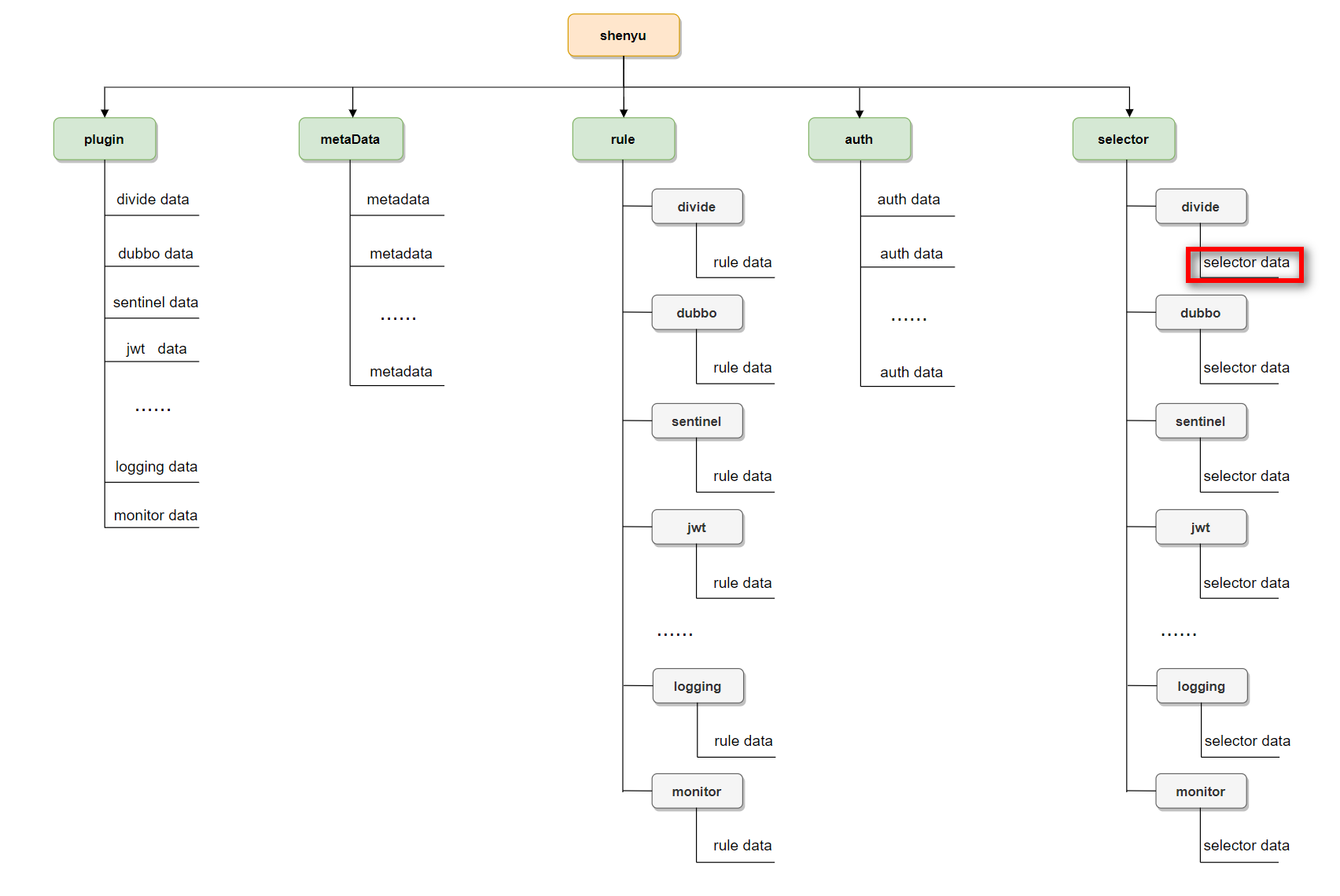
We series the above update flow with a sequence diagram.
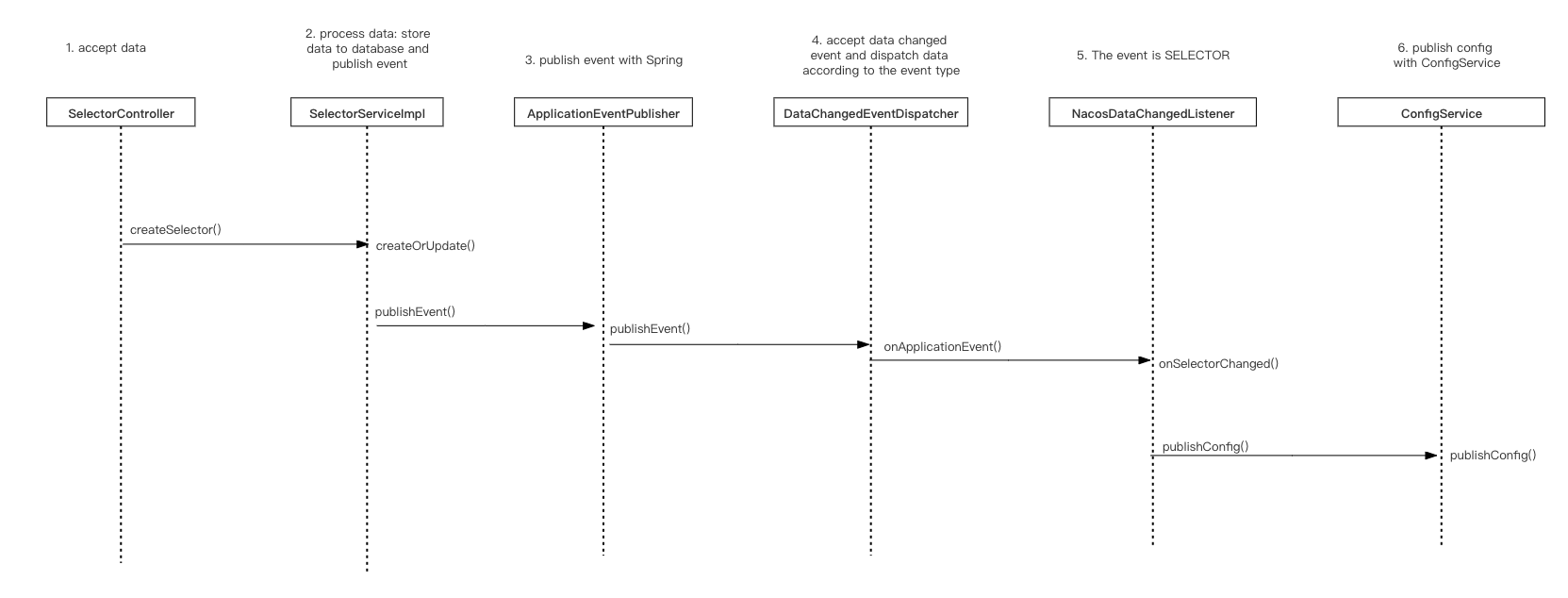
3. Gateway Data Sync#
Assume that the ShenYu gateway is already running properly, and the data synchronization mode is also nacos. How does the gateway receive and process the selector data after updating it on the admin side and sending the changed data to nacos? Let's continue our source code analysis to find out.
3.1 NacosSyncDataService Accept Data#
The gateway side use NacosSyncDataService to watch nacos and fetch the data update, but before we dive into this part, let us take a look on how the bean with the type NacosSyncDataService is generated. The answer is it's defined in the Spring config class NacosSyncDataConfiguration. Let's focus on the annotation @ConditionalOnProperty(prefix = "shenyu.sync.nacos", name = "url") on the class NacosSyncDataConfiguration again. We have met this annotation when we analyzed the NacosListener class on the Admin side before, this config class would take effect only and if only the condition on this annotation is matched. In other words, when we have the config as below on the gateway side, the gateway would use nacos to sync data and the config class NacosSyncDataConfiguration would take effect.
shenyu: sync: nacos: url: localhost:8848/** * Nacos sync data configuration for spring boot. */@Configuration@ConditionalOnClass(NacosSyncDataService.class)@ConditionalOnProperty(prefix = "shenyu.sync.nacos", name = "url")public class NacosSyncDataConfiguration {
private static final Logger LOGGER = LoggerFactory.getLogger(NacosSyncDataConfiguration.class);
/** * Nacos sync data service. * * @param configService the config service * @param pluginSubscriber the plugin subscriber * @param metaSubscribers the meta subscribers * @param authSubscribers the auth subscribers * @return the sync data service */ @Bean public SyncDataService nacosSyncDataService(final ObjectProvider<ConfigService> configService, final ObjectProvider<PluginDataSubscriber> pluginSubscriber, final ObjectProvider<List<MetaDataSubscriber>> metaSubscribers, final ObjectProvider<List<AuthDataSubscriber>> authSubscribers) { LOGGER.info("you use nacos sync shenyu data......."); return new NacosSyncDataService(configService.getIfAvailable(), pluginSubscriber.getIfAvailable(), metaSubscribers.getIfAvailable(Collections::emptyList), authSubscribers.getIfAvailable(Collections::emptyList)); }
/** * Nacos config service config service. * * @param nacosConfig the nacos config * @return the config service * @throws Exception the exception */ @Bean public ConfigService nacosConfigService(final NacosConfig nacosConfig) throws Exception { Properties properties = new Properties(); if (nacosConfig.getAcm() != null && nacosConfig.getAcm().isEnabled()) { properties.put(PropertyKeyConst.ENDPOINT, nacosConfig.getAcm().getEndpoint()); properties.put(PropertyKeyConst.NAMESPACE, nacosConfig.getAcm().getNamespace()); properties.put(PropertyKeyConst.ACCESS_KEY, nacosConfig.getAcm().getAccessKey()); properties.put(PropertyKeyConst.SECRET_KEY, nacosConfig.getAcm().getSecretKey()); } else { properties.put(PropertyKeyConst.SERVER_ADDR, nacosConfig.getUrl()); if (StringUtils.isNotBlank(nacosConfig.getNamespace())) { properties.put(PropertyKeyConst.NAMESPACE, nacosConfig.getNamespace()); } if (nacosConfig.getUsername() != null) { properties.put(PropertyKeyConst.USERNAME, nacosConfig.getUsername()); } if (nacosConfig.getPassword() != null) { properties.put(PropertyKeyConst.PASSWORD, nacosConfig.getPassword()); } } return NacosFactory.createConfigService(properties); }
/** * Http config http config. * * @return the http config */ @Bean @ConfigurationProperties(prefix = "shenyu.sync.nacos") public NacosConfig nacosConfig() { return new NacosConfig(); }}Let's focus on the part of code above which is about the generation of the bean nacosSyncDataService:
@Beanpublic SyncDataService nacosSyncDataService(final ObjectProvider<ConfigService> configService, final ObjectProvider<PluginDataSubscriber> pluginSubscriber, final ObjectProvider<List<MetaDataSubscriber>> metaSubscribers, final ObjectProvider<List<AuthDataSubscriber>> authSubscribers) { LOGGER.info("you use nacos sync shenyu data......."); return new NacosSyncDataService(configService.getIfAvailable(), pluginSubscriber.getIfAvailable(), metaSubscribers.getIfAvailable(Collections::emptyList), authSubscribers.getIfAvailable(Collections::emptyList));}As we can see, the bean is generated by the construction method of the Class NacosSyncDataService. Let's dive into the construction method.
public NacosSyncDataService(final ConfigService configService, final PluginDataSubscriber pluginDataSubscriber, final List<MetaDataSubscriber> metaDataSubscribers, final List<AuthDataSubscriber> authDataSubscribers) {
super(configService, pluginDataSubscriber, metaDataSubscribers, authDataSubscribers); start();} public void start() { watcherData(NacosPathConstants.PLUGIN_DATA_ID, this::updatePluginMap); watcherData(NacosPathConstants.SELECTOR_DATA_ID, this::updateSelectorMap); watcherData(NacosPathConstants.RULE_DATA_ID, this::updateRuleMap); watcherData(NacosPathConstants.META_DATA_ID, this::updateMetaDataMap); watcherData(NacosPathConstants.AUTH_DATA_ID, this::updateAuthMap); } protected void watcherData(final String dataId, final OnChange oc) { Listener listener = new Listener() { @Override public void receiveConfigInfo(final String configInfo) { oc.change(configInfo); }
@Override public Executor getExecutor() { return null; } }; oc.change(getConfigAndSignListener(dataId, listener)); LISTENERS.computeIfAbsent(dataId, key -> new ArrayList<>()).add(listener); }As we can see, the construction method calls the start method and calls the watcherData method to create a listener which relates itself to a callback method oc, since we're analyzing the changes on the component with the selector type, the relative callback method is updateSelectorMap. This callback method is used to handle data.
3.2 Handle Data#
- NacosCacheHandler.updateSelectorMap()
The data is not null, and caching the selector data is again handled by PluginDataSubscriber.
protected void updateSelectorMap(final String configInfo) { try { List<SelectorData> selectorDataList = GsonUtils.getInstance().toObjectMapList(configInfo, SelectorData.class).values().stream().flatMap(Collection::stream).collect(Collectors.toList()); selectorDataList.forEach(selectorData -> Optional.ofNullable(pluginDataSubscriber).ifPresent(subscriber -> { subscriber.unSelectorSubscribe(selectorData); subscriber.onSelectorSubscribe(selectorData); })); } catch (JsonParseException e) { LOG.error("sync selector data have error:", e); } }PluginDataSubscriber is an interface, it is only a CommonPluginDataSubscriber implementation class, responsible for data processing plugin, selector and rules.
3.3 Common Plugin Data Subscriber#
- PluginDataSubscriber.unSelectorSubscribe()
- PluginDataSubscriber.onSelectorSubscribe()
It has no additional logic and calls the unSelectorSubscribe()andsubscribeDataHandler() method directly. Within methods, there are data types (plugins, selectors, or rules) and action types (update or delete) to perform different logic.
/** * The common plugin data subscriber, responsible for handling all plug-in, selector, and rule information */public class CommonPluginDataSubscriber implements PluginDataSubscriber { //...... // handle selector data @Override public void onSelectorSubscribe(final SelectoData selectorData) { subscribeDataHandler(selectorData, DataEventTypeEnum.UPDATE); } @Override public void unSelectorSubscribe(final SelectorData selectorData) { subscribeDataHandler(selectorData, DataEventTypeEnum.DELETE); } // A subscription data handler that handles updates or deletions of data private <T> void subscribeDataHandler(final T classData, final DataEventTypeEnum dataType) { Optional.ofNullable(classData).ifPresent(data -> { // plugin data if (data instanceof PluginData) { PluginData pluginData = (PluginData) data; if (dataType == DataEventTypeEnum.UPDATE) { // update // save the data to gateway memory BaseDataCache.getInstance().cachePluginData(pluginData); // If each plugin has its own processing logic, then do it Optional.ofNullable(handlerMap.get(pluginData.getName())).ifPresent(handler -> handler.handlerPlugin(pluginData)); } else if (dataType == DataEventTypeEnum.DELETE) { // delete // delete the data from gateway memory BaseDataCache.getInstance().removePluginData(pluginData); // If each plugin has its own processing logic, then do it Optional.ofNullable(handlerMap.get(pluginData.getName())).ifPresent(handler -> handler.removePlugin(pluginData)); } } else if (data instanceof SelectorData) { // selector data SelectorData selectorData = (SelectorData) data; if (dataType == DataEventTypeEnum.UPDATE) { // update // save the data to gateway memory BaseDataCache.getInstance().cacheSelectData(selectorData); // If each plugin has its own processing logic, then do it Optional.ofNullable(handlerMap.get(selectorData.getPluginName())).ifPresent(handler -> handler.handlerSelector(selectorData)); } else if (dataType == DataEventTypeEnum.DELETE) { // delete // delete the data from gateway memory BaseDataCache.getInstance().removeSelectData(selectorData); // If each plugin has its own processing logic, then do it Optional.ofNullable(handlerMap.get(selectorData.getPluginName())).ifPresent(handler -> handler.removeSelector(selectorData)); } } else if (data instanceof RuleData) { // rule data RuleData ruleData = (RuleData) data; if (dataType == DataEventTypeEnum.UPDATE) { // update // save the data to gateway memory BaseDataCache.getInstance().cacheRuleData(ruleData); // If each plugin has its own processing logic, then do it Optional.ofNullable(handlerMap.get(ruleData.getPluginName())).ifPresent(handler -> handler.handlerRule(ruleData)); } else if (dataType == DataEventTypeEnum.DELETE) { // delete // delete the data from gateway memory BaseDataCache.getInstance().removeRuleData(ruleData); // If each plugin has its own processing logic, then do it Optional.ofNullable(handlerMap.get(ruleData.getPluginName())).ifPresent(handler -> handler.removeRule(ruleData)); } } }); } }3.4 Data cached to Memory#
Adding a selector will enter the following logic:
// save the data to gateway memoryBaseDataCache.getInstance().cacheSelectData(selectorData);// If each plugin has its own processing logic, then do itOptional.ofNullable(handlerMap.get(selectorData.getPluginName())).ifPresent(handler -> handler.handlerSelector(selectorData));One is to save the data to the gateway's memory. BaseDataCache is the class that ultimately caches data, implemented in a singleton pattern. The selector data is stored in the SELECTOR_MAP Map. In the subsequent use, also from this data.
public final class BaseDataCache { // private instance private static final BaseDataCache INSTANCE = new BaseDataCache(); // private constructor private BaseDataCache() { } /** * Gets instance. * public method * @return the instance */ public static BaseDataCache getInstance() { return INSTANCE; } /** * A Map of the cache selector data * pluginName -> SelectorData. */ private static final ConcurrentMap<String, List<SelectorData>> SELECTOR_MAP = Maps.newConcurrentMap(); public void cacheSelectData(final SelectorData selectorData) { Optional.ofNullable(selectorData).ifPresent(this::selectorAccept); } /** * cache selector data. * @param data the selector data */ private void selectorAccept(final SelectorData data) { String key = data.getPluginName(); if (SELECTOR_MAP.containsKey(key)) { // Update operation, delete before insert List<SelectorData> existList = SELECTOR_MAP.get(key); final List<SelectorData> resultList = existList.stream().filter(r -> !r.getId().equals(data.getId())).collect(Collectors.toList()); resultList.add(data); final List<SelectorData> collect = resultList.stream().sorted(Comparator.comparing(SelectorData::getSort)).collect(Collectors.toList()); SELECTOR_MAP.put(key, collect); } else { // Add new operations directly to Map SELECTOR_MAP.put(key, Lists.newArrayList(data)); } } }Second, if each plugin has its own processing logic, then do it. Through the IDEA editor, you can see that after adding a selector, there are the following plugins and processing. We're not going to expand it here.

After the above source tracking, and through a practical case, in the admin end to update a selector data, the ZooKeeper data synchronization process analysis is clear.
Let's series the data synchronization process on the gateway side through the sequence diagram:
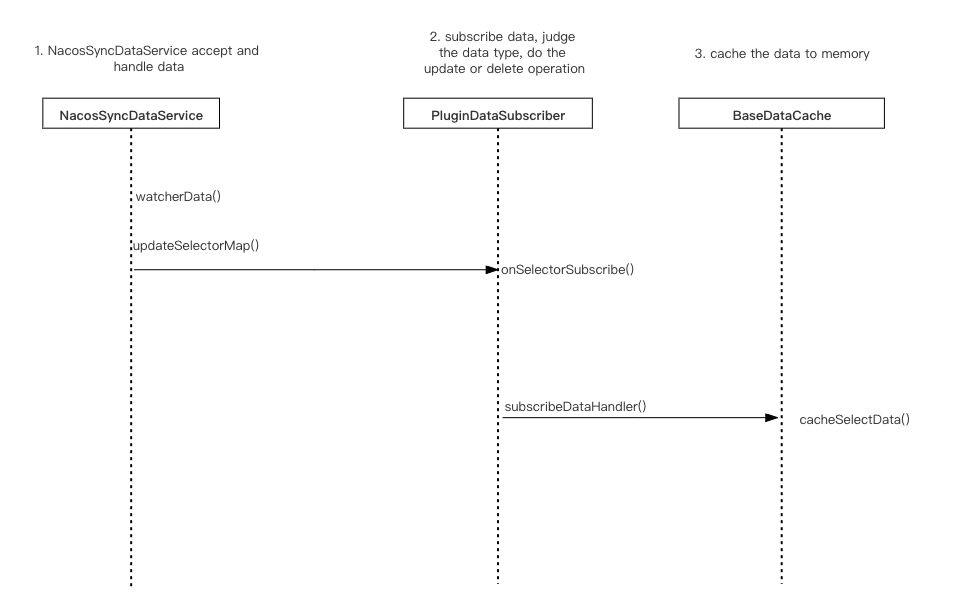
The data synchronization process has been analyzed. In order to prevent the synchronization process from being interrupted, other logic is ignored during the analysis. We have analyzed the process of gateway synchronization operation initialization in the start method of NacosSyncDataService class. We also need to analyze the process of Admin synchronization data initialization.
4. Admin Data Sync initialization#
On the admin side, the bean with the type NacosDataInit, is defined and generated in the NacosListener, if the configuration of the admin side decides to use nacos to sync data, when admin starts, the current data will be fully synchronized to nacos, the implementation logic is as follows:
/** * The type Nacos data init. */public class NacosDataInit implements CommandLineRunner {
private static final Logger LOG = LoggerFactory.getLogger(NacosDataInit.class);
private final ConfigService configService;
private final SyncDataService syncDataService;
/** * Instantiates a new Nacos data init. * @param configService the nacos config service * @param syncDataService the sync data service */ public NacosDataInit(final ConfigService configService, final SyncDataService syncDataService) { this.configService = configService; this.syncDataService = syncDataService; }
@Override public void run(final String... args) { String pluginDataId = NacosPathConstants.PLUGIN_DATA_ID; String authDataId = NacosPathConstants.AUTH_DATA_ID; String metaDataId = NacosPathConstants.META_DATA_ID; if (dataIdNotExist(pluginDataId) && dataIdNotExist(authDataId) && dataIdNotExist(metaDataId)) { syncDataService.syncAll(DataEventTypeEnum.REFRESH); } }
private boolean dataIdNotExist(final String pluginDataId) { try { String group = NacosPathConstants.GROUP; long timeout = NacosPathConstants.DEFAULT_TIME_OUT; return configService.getConfig(pluginDataId, group, timeout) == null; } catch (NacosException e) { LOG.error("Get data from nacos error.", e); throw new ShenyuException(e.getMessage()); } }}Check whether there is data in nacos, if not, then synchronize.
NacosDataInit implements the CommandLineRunner interface. It is an interface provided by SpringBoot that executes the run() method after all Spring Beans initializations and is often used for initialization operations in a project.
- SyncDataService.syncAll()
Query data from the database, and then perform full data synchronization, all authentication information, plugin information, selector information, rule information, and metadata information. Synchronous events are published primarily through eventPublisher. After publishing the event via publishEvent(), the ApplicationListener performs the event change operation. In ShenYu is mentioned in DataChangedEventDispatcher.
@Servicepublic class SyncDataServiceImpl implements SyncDataService { // eventPublisher private final ApplicationEventPublisher eventPublisher; /*** * sync all data * @param type the type * @return */ @Override public boolean syncAll(final DataEventTypeEnum type) { // app auth data appAuthService.syncData(); // plugin data List<PluginData> pluginDataList = pluginService.listAll(); eventPublisher.publishEvent(new DataChangedEvent(ConfigGroupEnum.PLUGIN, type, pluginDataList)); // selector data List<SelectorData> selectorDataList = selectorService.listAll(); eventPublisher.publishEvent(new DataChangedEvent(ConfigGroupEnum.SELECTOR, type, selectorDataList)); // rule data List<RuleData> ruleDataList = ruleService.listAll(); eventPublisher.publishEvent(new DataChangedEvent(ConfigGroupEnum.RULE, type, ruleDataList)); // metadata metaDataService.syncData(); return true; } }5. Summary#
This paper through a practical case, nacos data synchronization principle source code analysis. The main knowledge points involved are as follows:
Data synchronization based on
nacosis mainly implemented throughwatchmechanism;Complete event publishing and listening via
Spring;Support multiple synchronization strategies through abstract
DataChangedListenerinterface, interface oriented programming;Use singleton design pattern to cache data class
BaseDataCache;Loading of configuration classes via conditional assembly of
SpringBootandstarterloading mechanism.
